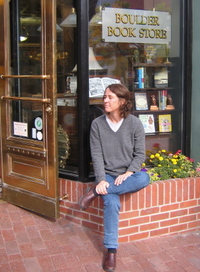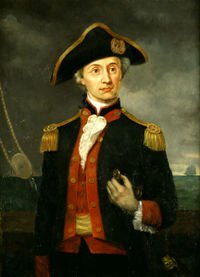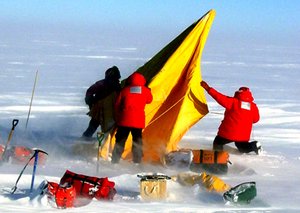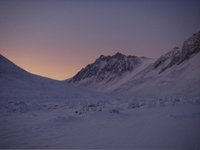Who is that webmaster?
 We're going to take a little break from the Antarctic to ask an important question: who is my webmaster. Many of you have been wondering--and well you might. Here are some clues as to who he is.
We're going to take a little break from the Antarctic to ask an important question: who is my webmaster. Many of you have been wondering--and well you might. Here are some clues as to who he is.
He is the one who said:
"An honorable blog is and always was my first wish! I can take no delight in the effusion of bandwidth; but, if this blog should continue, I wish to have the most active part in it. "
and:
"I have not yet begun to blog!"
and:
"I wish to have no connection with any blog that does not blog fast; for I intend to go in harm's way. "
he is a pretty quotable guy, so he also said this:
"If a website is cultivated it will become stronger, if a blog is cultivated it will achieve mastery."
He really can't be beat for good quotes:
"It seems to be a law of blogs, inflexible and inexorable, that those who will not blog cannot win."
We'll end with this:
"Whoever can blog well must conquer."
If you know who he is, please leave a comment.
We're going to take a little break from the Antarctic to ask an important question: who is my webmaster. Many of you have been wondering--and well you might. Here are some clues as to who he is.
He is the one who said:
"An honorable blog is and always was my first wish! I can take no delight
in the effusion of bandwidth; but, if this blog should continue, I wish to
have the most active part in it. "
and:
"I have not yet begun to blog!"
and:
"I wish to have no connection with any blog that does not blog fast; for I intend to go in harm's way. "
he is a pretty quotable guy, so he also said this:
"If a website is cultivated it will become stronger, if a blog is cultivated it will achieve mastery."
He really can't be beat for good quotes:
"It seems to be a law of blogs, inflexible and inexorable, that those who will not blog cannot win."
We'll end with this:
"Whoever can blog well must conquer."
If you know who he is, please leave a comment.
XTRA, XTRA: Read All About The Antarctic Sun

The best and cheapest all-points-north bulletin on the planet is delivered right to your doorstep by clicking The Antarctic Sun, a fun and exciting, web-based magazine with "News about the US Antarctic Program, the Ice, and the People." Funded by the National Science Foundation, The Sun brings you incredible tales and characters from the bottom of the planet (not unlike Antarctica: Life on the Ice by Yours Truly).
The current edition of The Sun tells the amazing story of a subglacial mountain range beneath the high plateau in East Antarctica "the size of the European Alps but buried below hundreds of meters of ice and snow [that] has puzzled and enticed Antarctic scientists since its discovery 50 years ago."
 This photograph by Doug Wiens accompanies the article. It is a dramatic and true image of the conditions that Antarctic researchers routinely endure. Click on it to enlarge. Here's the photo's caption from The Sun:
This photograph by Doug Wiens accompanies the article. It is a dramatic and true image of the conditions that Antarctic researchers routinely endure. Click on it to enlarge. Here's the photo's caption from The Sun:
"Researchers headed into the field for the seismic instrumentation of the AGAP project in 2007-08 can expect the same sort of extreme weather conditions experienced during TAMSEIS (2001-03), a project in the Transantarctic Mountains that used an earlier generation of seismometers for similar research."
An excerpt follows from The Sun story.
The best and cheapest all-points-north bulletin on the planet is delivered right to your doorstep by clicking The Antarctic Sun, a fun and exciting, web-based magazine with "News about the US Antarctic Program, the Ice, and the People." Funded by the National Science Foundation, The Sun brings you incredible tales and characters from the bottom of the planet (not unlike Antarctica: Life on the Iceby Yours Truly).
The current edition of The Sun tells the amazing story of a subglacial mountain range beneath the high plateau in East Antarctica "the size of the European Alps but buried below hundreds of meters of ice and snow [that] has puzzled and enticed Antarctic scientists since its discovery 50 years ago."
This photograph by Doug Wiens accompanies the article. It is a dramatic and true image of the conditions that Antarctic researchers routinely endure. Click on it to enlarge. Here's the photo's caption from The Sun:
"Researchers headed into the field for the seismic instrumentation of
the AGAP project in 2007-08 can expect the same sort of extreme weather
conditions experienced during TAMSEIS (2001-03), a project in the
Transantarctic Mountains that used an earlier generation of
seismometers for similar research."
An excerpt follows from The Sun story.
"How did it get there? What does it look like? How tall is it? What role did it play in the formation of the ice sheet?
Those are a few of the questions an international team of researchers
will attempt to answer beginning this season, as they venture into the
Antarctic Gamburstev Province (AGAP), a high-altitude region in East
Antarctica.
“We don’t know why that mountain range is there. It’s really a
mystery,” said Robin Bell, a principal investigator for AGAP’s
aerogeophysical component, nicknamed GAMBIT. “It’s kind of like finding
a mountain range in the middle of Canada.”
A Soviet overland traverse discovered the Gamburtsev subglacial range
during the International Geophysical Year in 1958. Scant other data
exist aside from a few aerogeophysical surveys dating back to the 1970s.
A multi-nation effort to study the subglacial mountain range in more
detail came together as a result of the International Polar Year (IPY).
U.S. investigators are teaming with scientists from the United Kingdom,
Germany, China, France, Italy, Japan and Australia to tackle a place
that is logistically tough to work alone." The full text at The Antarctic Sun
Bill Jirsa: "Antarctica Trumped my Funk"
 It's hard to describe Ice People--but if I had one word it would be eclectic. I was fascinated, intrigued and often in awe of those I met, so in these pages I will introduce you to some, and have them describe their experiences this season. So: meet Bill Jirsa, computer wizard, master of languages, and a beautiful writer. I recently asked him what he was up to on the ice and this is his amazing response. You can find more of his writing at icetongue (the world’s southernmost literary journal) or on his website elementarypenguin.
It's hard to describe Ice People--but if I had one word it would be eclectic. I was fascinated, intrigued and often in awe of those I met, so in these pages I will introduce you to some, and have them describe their experiences this season. So: meet Bill Jirsa, computer wizard, master of languages, and a beautiful writer. I recently asked him what he was up to on the ice and this is his amazing response. You can find more of his writing at icetongue (the world’s southernmost literary journal) or on his website elementarypenguin.
Bill writes: I was stranded at Lake Hoare last week. The weather changed while I was there to install the computer systems. I had about one day of work, and I ended up there for six nights as the weather remained just dodgy enough to cancel helo flights. I had to stay close to the radio through the day in case the weather opened up, but each day by about 3 or 4 pm they would cancel the day outright and tell the pilots to get some sleep. That’s when I set out for a night of wandering the Taylor Valley. This is my fourth season working in Antarctica. My job seldom takes me far from the station, and I’ve resisted returning to work here this year—thinking I should grow up and get a job where I don’t live in a dorm, start cooking for myself again. Mostly I’ve started to feel a bit sad that Antarctica has begun to feel ordinary to me.
It's hard to describe Ice People--but if I had one word it would be eclectic. I was fascinated, intrigued and often in awe of those I met, so in these pages I will introduce you to some, and have them describe their experiences this season. So: meet Bill Jirsa, computer wizard, master of languages, and a beautiful writer. I recently asked him what he was up to on the ice and this is his amazing response. You can find more of his writing at icetongue (the world’s southernmost literary journal) or on his website elementarypenguin.
Bill writes: I was stranded at Lake Hoare last week. The weather changed while I was there to install the computer systems. I had about one day of work, and I ended up there for six nights as the weather remained just dodgy enough to cancel helo flights. I had to stay close to the radio through the day in case the weather opened up, but each day by about 3 or 4 pm they would cancel the day outright and tell the pilots to get some sleep. That’s when I set out for a night of wandering the Taylor Valley. This is my fourth season working in Antarctica. My job seldom takes me far from the station, and I’ve resisted returning to work here this year—thinking I should grow up and get a job where I don’t live in a dorm, start cooking for myself again. Mostly I’ve started to feel a bit sad that Antarctica has begun to feel ordinary to me.
There’s about a half hour from 10:30 to 11:00p each night this time
of year when the sun wheels around to the south and aligns with the
slot between the peaks over the Taylor Glacier and if it happens to
clear up, the evening light spills in like butterscotch (as Joni
Mitchell would say), and the face of the glaciers light up like
multifaceted glass. I was partway up a ridge in a particular location
that should remain undisclosed. I felt the cold starting to seep in as
soon as I stopped to watch the light, frost on my eyelashes, flapping
my arms to keep warm—but comfortably within my personal system for
staying warm in this climate. The ridge across the valley lit up as the
golden light began to crawl across the valley floor. I poured myself a
cup of green tea from my thermos (I take it a little too strong and a
little too sweet to keep me going on long hikes).
The sound of me sipping was remarkable—I noted suddenly how deafeningly
quiet and calm it had become, and I realized that the only sound I’d
heard for the last seven hours was my own breathing, my own feet
crunching on the fresh snow. I had become mesmerized by the cavalcade
of my own thoughts as I’d hiked, and I realized that for the first time
in four seasons on this continent, I was utterly alone in Antarctica.
There were only two other people at all in this entire valley and they
were miles away and I knew they’d be fast asleep by now. (My radio was
off inside my pocket.) The light rolled around and climbed the ridge
where I stood, and the effect of the radiation was immediate—I shed my
parka and watched the sweat steaming off my fleece, felt the back of my
hands warming when I held them to the light, and I had to admit that
this place had trumped my funk: alright, I conceded aloud, this was an
extraordinary moment.
In a few more moments, the sun slipped behind the peaks, and the valley
returned to hard blue shadow, biting cold air in my nostrils. I packed
up and started walking again— The weather had cleared. I had a
scheduled helo pickup in about 9 hours and that was at least six or
seven hours on foot from where I stood. If I hustled, I might get a
quick nap before I had to get back to McMurdo.
Antarctica: Life on the Road
 Antarctica: Life on the Ice hit the road this past weekend. First stop: Boulder, Colorado where I read with Traci Macnamara and Beth Bartel.
Traci brought a blow-up globe so that everyone would know where the
Antarctic is (not "up there with the polar bears"). She read from her
essay about spending Thanksgiving on the ice, while Beth read from her
essay that describes her time spent on Mt. Erebus. They were both
stars. In the audience were a lot of ice people, including Elaine Hood,
from Raytheon who was my guardian angel during my trip. And then there were friends and fellow writers BK Loren and Sallie Greenwood. Christine Weeber, who contributed to Solo: On Her Own Adventure showed up, as did Jenny Dellaport, from my hometown of State College, PA! Watch for news of more readings at my website: www.susanfoxrogers.com
Antarctica: Life on the Ice hit the road this past weekend. First stop: Boulder, Colorado where I read with Traci Macnamara and Beth Bartel.
Traci brought a blow-up globe so that everyone would know where the
Antarctic is (not "up there with the polar bears"). She read from her
essay about spending Thanksgiving on the ice, while Beth read from her
essay that describes her time spent on Mt. Erebus. They were both
stars. In the audience were a lot of ice people, including Elaine Hood,
from Raytheon who was my guardian angel during my trip. And then there were friends and fellow writers BK Loren and Sallie Greenwood. Christine Weeber, who contributed to Solo: On Her Own Adventure showed up, as did Jenny Dellaport, from my hometown of State College, PA! Watch for news of more readings at my website: www.susanfoxrogers.com
Antarctica: Life on the Ice hit the road this past weekend. First stop: Boulder, Colorado where I read with Traci Macnamara and Beth Bartel.
Traci brought a blow-up globe so that everyone would know where the
Antarctic is (not "up there with the polar bears"). She read from her
essay about spending Thanksgiving on the ice, while Beth read from her
essay that describes her time spent on Mt. Erebus. They were both
stars. In the audience were a lot of ice people, including Elaine Hood,
from Raytheon who was my guardian angel during my trip. And then there were friends and fellow writers BK Loren and Sallie Greenwood. Christine Weeber, who contributed to Solo: On Her Own Adventure showed up, as did Jenny Dellaport, from my hometown of State College, PA! Watch for news of more readings at my website: www.susanfoxrogers.com




